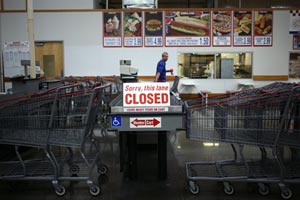Consumer Spending in Stalls in March

U.S. consumer spending stalled in March while inflation slowed to below the Federal Reserve’s target, showing the biggest part of the economy might take more time to gain momentum after a tepid start to the year.
Purchases were little changed in both March and February from their prior months, Commerce Department figures showed May 1. The median forecast of economists in a Bloomberg News survey called for a 0.2% advance. Incomes rose 0.2%, with falling prices applying a drag on the nominal figures.
The figures were foreshadowed in an April 28 report on gross domestic product that showed the slowest first quarter for household spending since 2009. Analysts are expecting the consumer to bounce back, as there’s still plenty for Americans to cheer about in the economic outlook, including a steady job market.
“Spending numbers were soft in February and March, but it’s not necessarily the end of the world,” since the figures follow a strong fourth quarter, said Scott Brown, chief economist at Raymond James Financial Inc. in St. Petersburg, Florida. “If we don’t see a rebound in the numbers we get for April and May, that would be concerning. But the fundamentals are still sound for the consumer.”
The Bloomberg survey median called for incomes to rise 0.3%. Wages rose 0.1% in March after a 0.5% gain the prior month.
Disposable income, or the money remaining after taxes, increased 0.5% in March from the prior month after adjusting for inflation, the fastest gain since December 2015. It was up 2.4% over the past year, compared with a 2.2% year-over-year gain in February. The saving rate increased to 5.9% from 5.7% in February.
Projections for consumer spending in the Bloomberg survey ranged from a decline of 0.2% to a 0.4% increase. The previous month’s reading was initially reported as a 0.1% advance.
After adjusting for inflation, in order to generate the figures used to calculate gross domestic product, purchases increased 0.3% in March after a 0.1% decline in February, the May 1 report also showed.
Durable-goods purchases fell 0.7% after adjusting for inflation, in a month marked by a decline in auto sales, while spending on nondurable goods was up 0.3%. Household outlays on services increased 0.4%, following a 0.2% drop in February. The services category, which also includes tourism, legal help, health care and personal care items such as haircuts is typically difficult for the government to estimate accurately until more information is available in later months.
The personal spending report showed the price index tied to consumer purchases fell 0.2% in March from the prior month, the first decline since February 2016. It rose 1.8% from the same time in 2016. That marks a slowdown after the inflation gauge, which is preferred by Federal Reserve policymakers, climbed above their 2% goal in February for the first time since April 2012.
Fed officials have used bubbling inflation as one reason to gradually increase the benchmark interest rate. They did so in March, and have signaled the potential for two more quarter-point rate hikes this year. Policymakers, who meet this week, said after their last meeting in March that they’re seeking a “sustained return to 2% inflation.”
Stripping out the volatile food and energy categories, the price measure fell 0.1% from February, the first drop since September 2001. It was up 1.6% in the 12 months ended in March.

